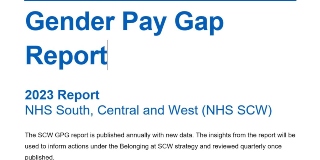
Summary
This report in total represents 1,806 NHS South, Central and West (SCW) employees (1,073 females and 733 males) for the period 1 April 2022 to 31 March 2023.
We are pleased to report a significant reduction in our median gender pay gap from 7.35% in 2022 to 2.57% in 2023, and a decrease in our mean gender pay gap from 7.78% to 7.49%.
Positively, this report demonstrates a continuing downward trend in our gender pay gap since reporting began in 2017 with an overall reduction in both mean and median pay gaps.
The reduction in our median gap suggests an improvement in the distribution of female employees across pay bands.The biggest gap in representation compared to the whole workforce remains at Band 3 where female employees are overrepresented by 21.1% (decrease from 24.1% in 2022) bringing down the mean and median hourly rate for female employees.
Female employees continue to be most under-represented at Band 8d where the proportion was 14.8% lower than the whole workforce representation. This gap has also reduced since 2022.
A significant driver to our pay gap is the lower proportion of male employees in lower pay bands compared to the overall workforce.
Female staff
As at 31 March 2023, SCW employed a total of 1,806 people (headcount) on permanent or fixed-term contracts. Of this number, 59.4% (1,073) were female and 40.6% (733) were male.
What is SCW's gender pay gap?
SCW recognises that we have a gender pay gap.
Based on the Government’s calculation methodology, we have a mean gender pay gap of 7.49% and a median gender pay gap of 2.57%. The mean gap has reduced by 0.29% and our median gap has reduced by 4.78% since 2022.
This means that our average male salary remains higher than our average female salary.
Gender pay gap March 2023 | Mean | Median |
|---|---|---|
Male hourly rate | £24.35 | £21.30 |
Female hourly rate | £22.52 |
|
Percentage pay gap | 7.49% | 2.57% |
SCW mean gender pay gap
SCW median gender pay gap
Bonus gender pay gap
We do not pay bonuses to our employees, since there is no scope for them within the Agenda for Change and VSM terms and conditions of service.
What is the proportion of employees in each pay quartile?
As at 31 March 2023
- 59.4% of all SCW employees were female (a decrease since 2022 from 60.6%)
- 68.6% of employees in the lower pay quartile were female (a decrease since 2022 from 77.8%)
- 51.8% of employees in the upper pay quartile were female (an increase since 2022 from 51.7%)
Female employees continue to be highly overrepresented in our lowest pay quartile (+9.2%) and underrepresented in our highest pay quartile (-7.6%) compared to representation within the whole workforce. This distribution is a key factor contributing to our mean and median gender pay gaps since it serves to bring down the average pay of female employees.
Female employees by pay quartile (percentage)
Positively, underrepresentation of female employees across the upper, upper middle and lower middle quartiles has reduced from 2022 to 2023. Overrepresentation of female employees has also decreased by 8.0% in the lower quartile since 2022, contributing to the reduction seen in our median gender pay gap.
What is the proportion of employees in each pay band?
Female employees by pay band
From 2022 to 2023, the distribution of male and female employees shifted towards a more representative balance across most pay bands, apart from Bands 4, 5, 8b and 9.
The biggest gap in representation compared to the whole workforce remains at Band 3 where female employees are overrepresented by 21.1% (decrease from 24.1% in 2022) bringing down the mean and median hourly rate for female employees.
Female employees continue to be most underrepresented at Band 8d where the proportion was 14.8% lower than the whole workforce representation, however this gap has also reduced since 2022.
The graphs above illustrate the gender distribution of SCW employees by presenting the percentage of female employees in each pay band. Band 2 roles are not displayed here as the headcount at this band is low and could be identifiable. They have been included in the overall workforce, gender pay gap and pay quartile data. Very Senior Managers (VSM), Ad Hoc Payscales and GP Workforce have been categorised together as they fall outside of the Agenda for Change payscales.
Employees by pay band, overall volume and percentage
Pay band | No. employees | Percentage |
|---|---|---|
Band 9 | 25 | 1.4% |
Band 8D | 56 | 3.1% |
Band 8C | 79 | 4.4% |
Band 8B | 164 | 9.1% |
Band 8A | 227 | 12.6% |
Band 7 | 310 | 17.2% |
Band 6 | 280 | 15.5% |
Band 5 | 286 | 15.5% |
Band 4 | 160 | 8.9% |
Band 3 | 159 | 8.8% |
VSM/AdHoc/GP Workforce | 59 | 3.3% |
Download the full report

Download the Gender Pay Gap Report (March 2023 snapshot) PDF.
Addressing our gender pay gap - what have we done so far?
- Developed diverse and inclusive recruitment training for all recruiting managers
- Worked towards greater gender representation at all levels, particularly senior leadership and our graduate management scheme
- Analysed our staff survey data to compare experiences including EDI and wellbeing, line management and appraisals from a perspective of gender
- Raised awareness and understanding of health issues impacting women in the workplace by signing the Menopause in the Workplace charter and providing resources and learning across our internal platforms
- Participated in the NHS Diversity in Health and Care Partners Programme and the NHS Health and Care Women Leaders Network
- Explored the value and desire to set up our own women’s network
Next steps
Our gender pay gap data forms part of a key dashboard of measures to assess progress against our Belonging at SCW strategy.
Additionally, we have partnered with the Employers Network for Equality and Inclusion (ENEI) and will be utilising their Talent Inclusion and Diversity Evaluation Tool to externally validate our progress and approach. We will look to make the most of this partnership to help identify actions to further reduce our gender pay gap and work to balance our workforce gender split.
We will also connect more with NHS Confederation Health and Care Women’s Leadership Network as a further avenue to progress in this space.
Based on the analysis presented here and suggestions within the NHS Employers Addressing your Gender Pay Gap guide and the NHS EDI Improvement Plan, we have a number of further recommendations that support our Belonging at SCW strategy:
- Further analyse our gender pay gap across other protected characteristics and service lines, exploring any intersectional trends
- Review workforce recruitment data from a gender perspective across attraction, application, recruitment, promotion, and retention to identify opportunities for improvement
- Monitor compliance with new recruitment training and resulting outcomes
- Analyse our part-time workforce from a pay band and gender perspective to better understand flexible working opportunities and part-time roles at senior levels
Background to the report
A gender pay gap report measures and compares mean and median hourly earnings for men and women across all jobs in a workforce. The difference between the average for men and the average for women is known as the gender pay gap.
Our gender pay gap calculations are based on pay-related information, extracted using the business intelligence reporting tool within the Electronic Staff Records (ESR) database. Details reported are those held as of 31 March 2023 for all ‘full-pay relevant employees’, meaning employees who were paid their usual full basic pay during the reporting period. It should be noted that bonus payments are not made to SCW employees, therefore we have presented no information for this measure.
ESR currently offers only binary options of ‘male’ and ‘female’ for employees to identify their gender to reflect the legal requirements of HMRC and GPG reporting. For this report, employees have been categorised as male or female based on their recorded gender identify in ESR.
What does the audit cover?
The purpose of a gender pay gap audit is to compare the pay of male and female employees to identify any differences in average pay.
Here we provide information on:
- the mean gender pay gap – calculated as the percentage difference between the average hourly salary for male employees and the average hourly salary for female employees
- the median gender pay gap – calculated as the percentage difference between the mid-point hourly salary for male employees and the mid-point hourly salary for female employees
- the proportion of males and females in each pay quartile – calculated by ranking all employees from highest to lowest paid, dividing the workforce into four numerically equal parts (‘quartiles’) and working out the percentage of male employees and female employees in each of the four parts.
Gender pay gap analysis does not look at whether there are differences in pay for men and women in equivalent posts. Neither does it take into consideration the differences in the number of people in each role. Therefore, results will be affected by differences in the gender composition of different professional groups and job grades.
Our gender pay gap calculations are based on pay-related information, extracted using the business intelligence reporting tool within the Electronic Staff Records (ESR) database. Details reported are those held as of 31 March 2023 for all permanent and fixed-term employees.
Our remuneration policy
96.7% of SCW employees are on NHS Agenda for Change terms and conditions, with pay bands ranging from apprentice roles at band 2 (lowest) to senior managers at band 9.
The NHS Job Evaluation System allocates posts to set pay bands, in accordance with levels of responsibility and other factors. As employees successfully develop their knowledge, skills and experience, they progress in annual pay steps up to the maximum of their pay band. Beyond band 9, the framework for the remuneration of Very Senior Managers (VSMs) is set by the Department of Health through the VSM Pay Framework.
NHS pay is governed by HM Treasury‘s pay remit process and is subject to current public sector pay rules and pay restraint.
Employees based in or around London are eligible for High-Cost Area Supplements (HCAS). As an indication of the value of these, for the reporting period (2022-2023), such payments ranged between £1,136 and £7,377 per annum.


